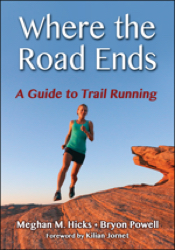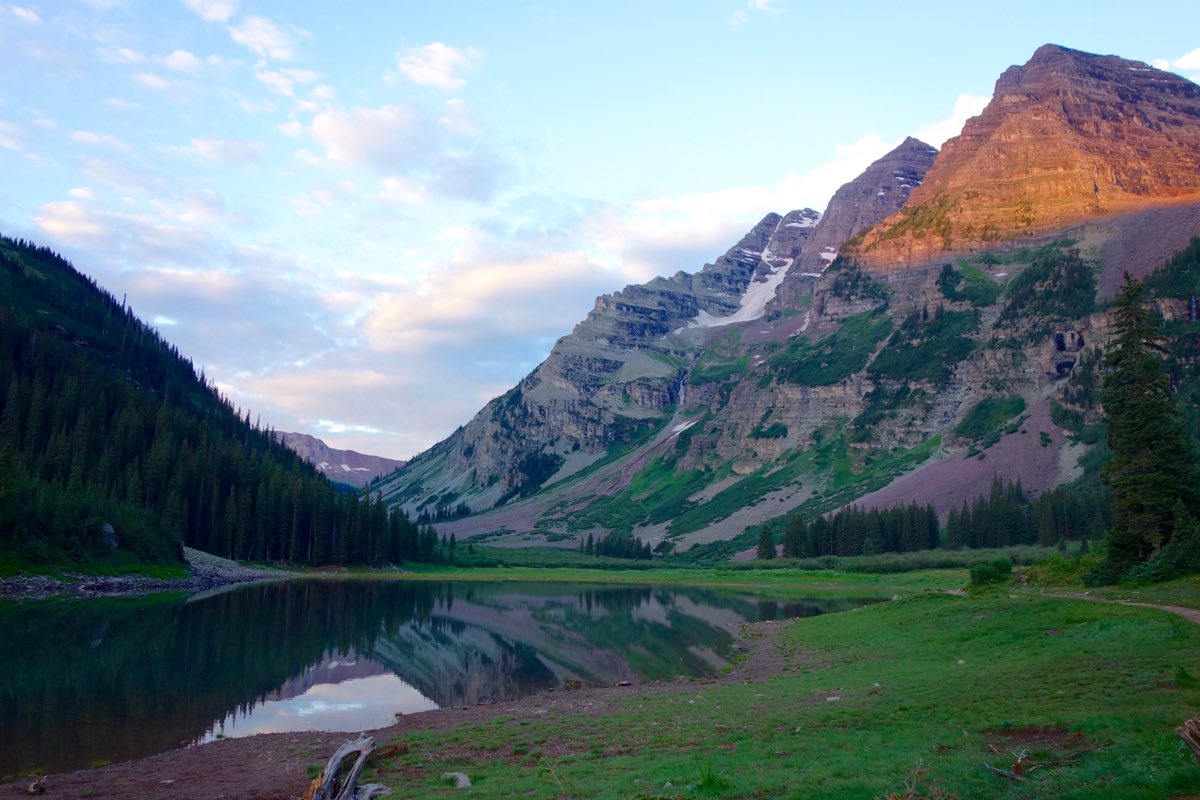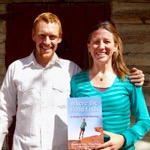
Like this article? Check out our book “Where the Road Ends!”
Welcome to iRunFar’s new column “Where the Road Ends: A Guide to Trail Running!” If that name sounds familiar, that’s because it’s also the title of the book Meghan Hicks and Bryon Powell of iRunFar published in 2016. The book Where the Road Ends: A Guide to Trail Running is a how-to guide for trail running. We worked with publisher Human Kinetics to develop a book offering the information anyone needs to get started, stay safe, and feel inspired with their trail running. The book Where the Road Ends teaches you how to negotiate technical trails, read a map, build your own training plan, understand the basics of what to drink and eat when you run, and so much more.
This column aims to do the same by publishing sections from the book as well as encouraging conversation in the comments section of each article. We want you to feel inspired and confident as you take to the trails. This month, we share the book’s introduction which exemplifies some of the elements of an excellent trail run–friendship, adventure, and the beauty of nature. Enjoy!
Welcome to “Where the Road Ends”
Very little light has crept into the sky as my good friend Kristin Zosel and I, Meghan Hicks, greet each other with a still-sleepy hug in the trailhead parking lot. What light has arrived is yellow, the precise color that the sun burns into your eyes if you make the mistake of looking straight at it, and it is pressing its way across the electric-blue sky of waning night. Tall, black silhouettes looming up from the ground are the giant mountains that surround us. We meet this morning to run the famed Four Pass Loop in Colorado’s Maroon Bells–Snowmass Wilderness. It’s a 26.5-mile (42.6-kilometer) loop outside Aspen that features a bold 8,000 vertical feet (2,400m) of climbing (and as much descending), largely through high-altitude, alpine terrain.
We head up the trail where a rock garden greets us for the first stretch of running. Our feet tap a staccato rhythm on the small spots of bare earth between the rocks, and our knees rise high to lift our legs over the obstacles. Our arms swing hard, instigating more forward propulsion than normal because our legs are busy with tasks beyond just moving forward. Moving requires the full attention of our minds and bodies, a natural wake-up call.
The trail leads to Crater Lake, its surface a perfectly still mirror that reflects everything: the conifer trees on its shoreline, North Maroon Peak and its companion mountains glowing pink in alpenglow, and a pale blue sky containing poofs of white clouds. We stand silent for a moment before jogging on.
We turn left at the trail junction and head up the West Maroon Creek drainage on a well-established trail that traces the valley bottom uphill. Here and there the trail is briefly muddy. I concentrate on making sure that my feet land right beneath me and straight into the ground so that the lugs on the soles of my shoes can grab the gook. With a little attention, good traction comes easily.
Kristin and I alternately jog and powerhike up the large valley. When the trail steepens, our heart rates spike, and we temporarily slow to a powerhike. As the trail moderates again, we switch back to a jog. Our bodies naturally seek the most efficient way to move across the dynamic terrain. The hillsides are choked with wildflowers—Indian paintbrush, lupine, and dozens of other species. Strokes of red, purple, yellow, and orange flash up the hillsides before giving way to the coral pink and rust-colored bare cliffs above. Simply said, the scene is stupendous.
We reach the first of the four namesake passes on this loop, West Maroon Pass, which acts as the topographical divide between two drainages. We’ve watched the clouds grow big and gray, expanding from separate units into a continuous layer. At the top of West Maroon Pass, we see an ominous curtain of rain falling a couple miles off and headed our way. We stop for just a moment—to take photos and don our rain jackets—before bulleting downhill.
Raindrops come first; they patter gently against my jacket. Then tiny pieces of hail begin to tap Morse code on my hood. Next comes a soaking rain. But just as the curtain of rain envelops us, we see through to the other side. The rain ends within 15 minutes, just long enough to soak our shoes.
The second pass, Frigid Air Pass, comes unexpectedly fast. At a little pond, the trail makes a quick, signed jog to the right and then pitches into the sky. Just a half mile (800m) to the top, the steep grade forces us to hike every step. I remind myself to inhale deeply with each breath to give myself access to as much oxygen as possible and to engage my core muscles, which act as the support structure for this hard work. We leave the bounty of wildflowers and ascend through rocky terrain devoid of nearly all vegetation.
Another trail runner climbs the opposite approach to the pass. We watch him tackle the switchbacks with command. He mostly jogs, although occasionally he switches to a powerhike for a couple steps, pressing his hands down on his thighs to add extra, upper-body oomph to each step.
In the valley after the pass, we encounter one backpacking group after another, maybe 75 people total over the next 10 miles (16k). We also intersect another pair of trail runners sauntering together. The Four Pass Loop is a mecca for outdoor enthusiasts of many kinds.
The 2,000-foot (600m) climb to the third pass comes in what seems like two giant stair steps. First, the trail steepens as we snake up a forested hillside on switchbacks. Just past treeline, the grade flattens as we meander past another unnamed pond. Trail Rider Pass is now in view, a V dipping into a ridge of rocks maybe 800 feet (240m) above us, the second of the two big stairs. In the nook of the V, humans who are already up there appear as wee dots, like ants.
We make it to the top, but not without hard work. Trail Rider Pass lies on the shoulder of a mountain made of white igneous rock called Snowmass Peak. Although the pass is above 12,000 feet (3,600m), the summit of the mountain is a couple thousand feet higher at over 14,000 feet (4,200m). The walls of white that rise from the pass are so reflective of the sun that they are almost blinding.
Below Trail Rider Pass and Snowmass Peak lies a giant lake, suitably named Snowmass Lake. It’s turquoise and glittery. Sunlight flashes off thousands of ripples as if a massive tropical fish were laid out on its side.
Somewhere below the pass, we stop for a snack. Before this morning, Kristin and I hadn’t seen each other for more than six months. But our conversation and friendship easily picked up where we last left it. All day we’ve chatted away, catching each other up on the comings and goings of life and then lapsing into the kind of comfortable silence that only two people who get along well can share. The ease of being with Kristin is a highlight of the day. As we stand there, under the hulking peak and above the sparkling lake, laughing and crunching on energy bars, I feel levity—about life and our friendship and this wild place. It’s a runner’s high.
Ahead of us looms one more pass, Buckskin Pass, but the trail makes us dip lower still before we climb again. We cross Snowmass Creek and start the 1,500-foot (450m) ascent. There’s no way to describe this point in our journey other than grinding. Kristin and I have been moving conservatively all day, so although it hurts a little, we are able to powerhike and jog hard. When we get to the top, we hug and high-five. We’re four for four, and the hardest work of the day is done!
Down Minnehaha Gulch we go, some 3,000 feet (900m) back toward Crater Lake, where things began this morning. There’s no way around it; the final downhill of many long trail runs is a challenge. The eccentric muscular contractions that come with simultaneously bending our legs and supporting our bodyweight makes our already tired quadriceps burn. Our brains are tired, so although the trail is buffed out enough in some places that we can cruise, in others we have to concentrate hard so that we don’t trip over exposed rocks and roots.
After what seems like a long time, we finish off the descent, rolling through the trail junction near Crater Lake, taking one last left back toward the trailhead. We’re back in the rock garden, our final segment of the day, and we play. We dance. We leap from rock to rock. We are completely joyful. We move efficiently, lightly, even picking up speed in this human version of smelling the barn.
At the trailhead, we peel ourselves out of our dirty, damp socks and shoes, grab our recovery drinks, and make our way to a cold creek to soak our tired legs.
“Now that was a ladies’ day out!” we hoot about our frolicking, rollicking day.
Excerpted from Where the Road Ends: A Guide to Trail Running, by Meghan Hicks and Bryon Powell. Human Kinetics © 2016.
Call for Comments
- Can you remember a trail run early in your relationship with the sport that totally captivated you and made you want to run off road a lot more? Can you share that story?
- What among your trail running knowledge and skills could use some further development? Where do you think you could learn a little more?

